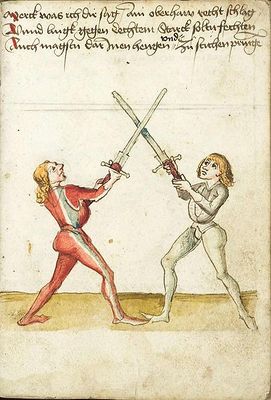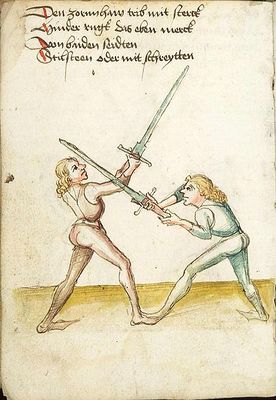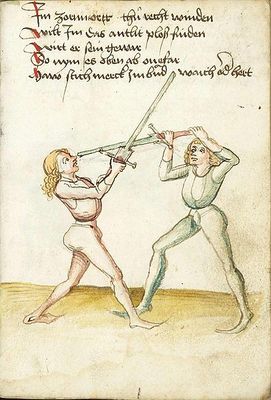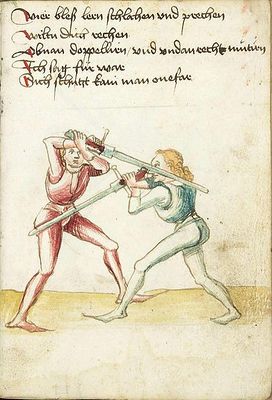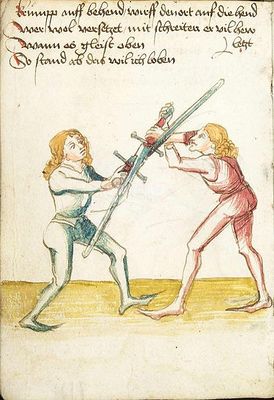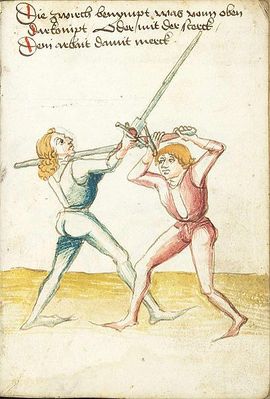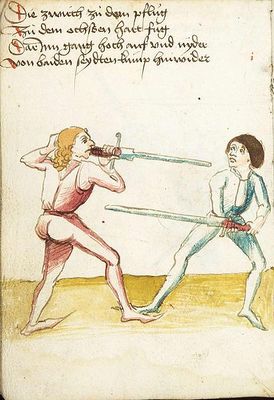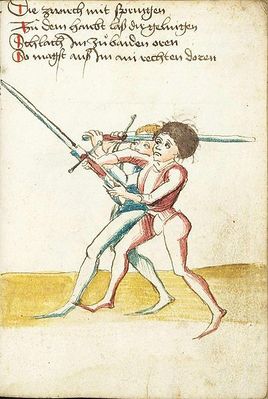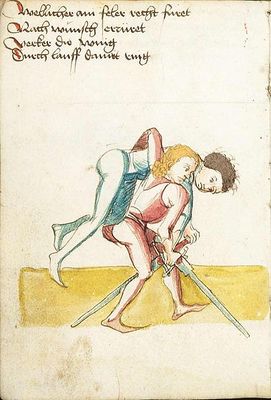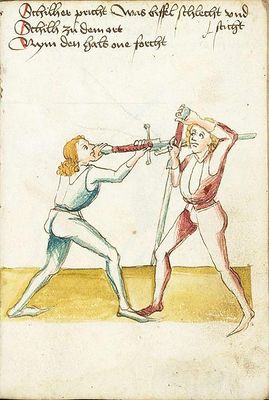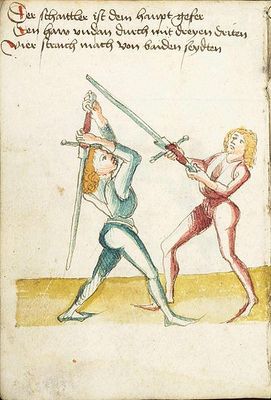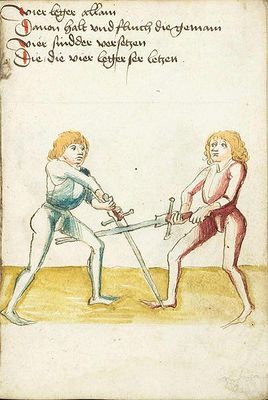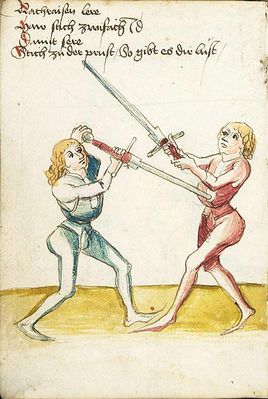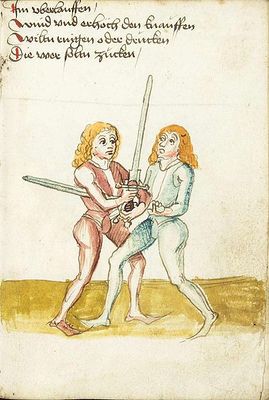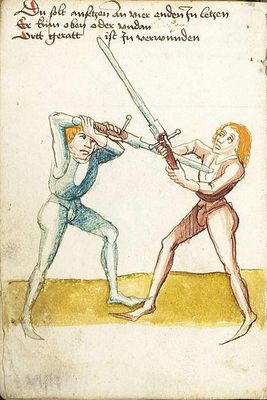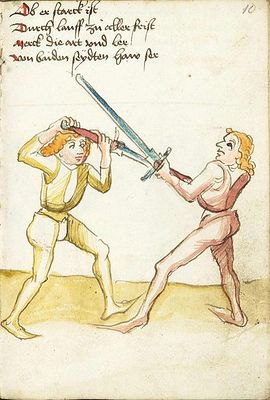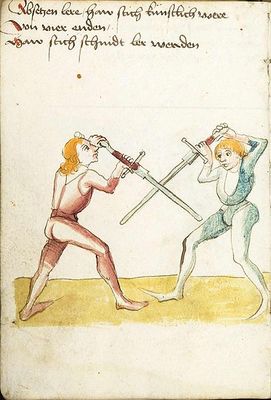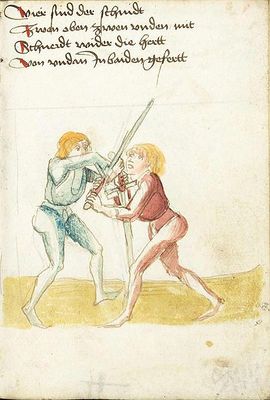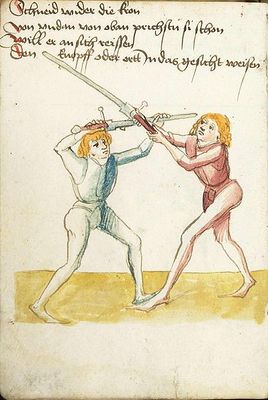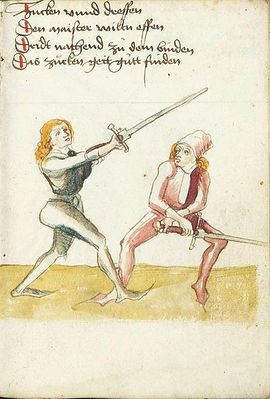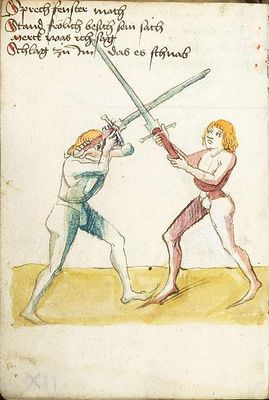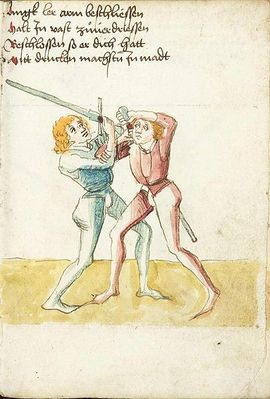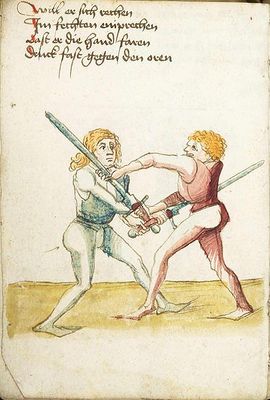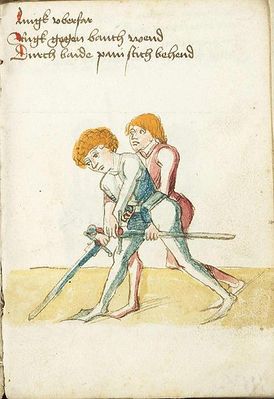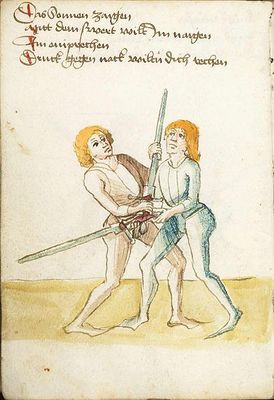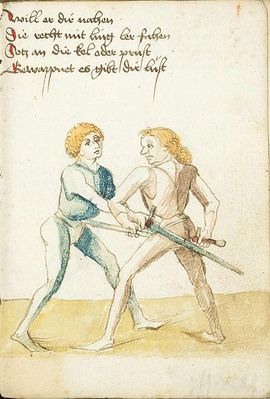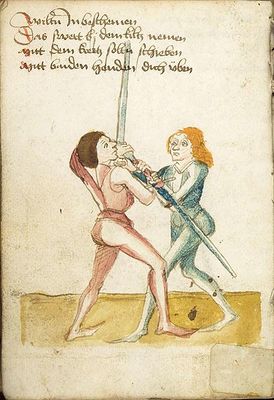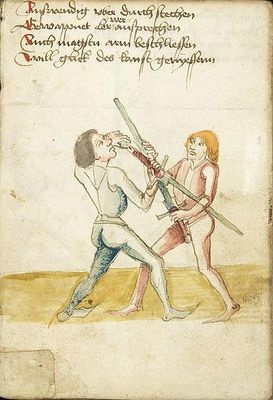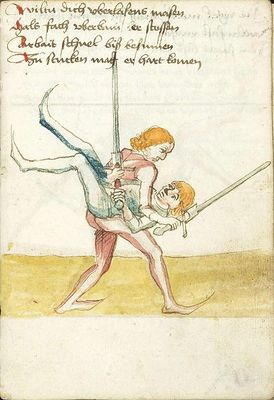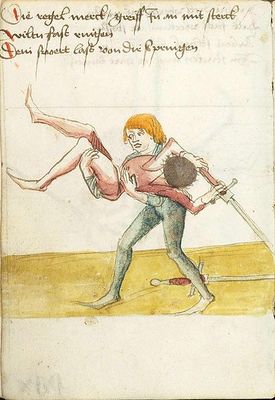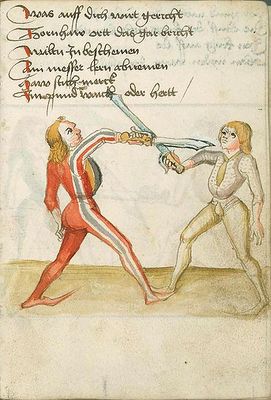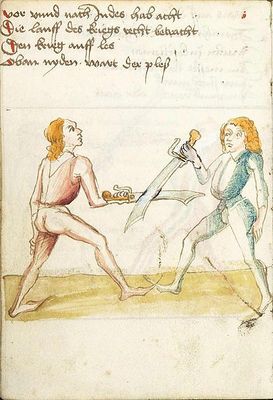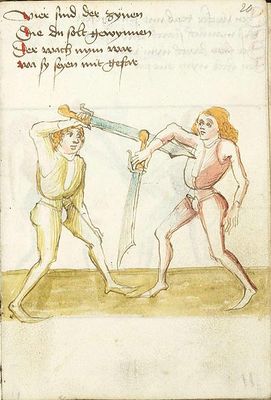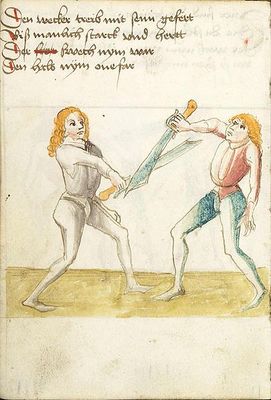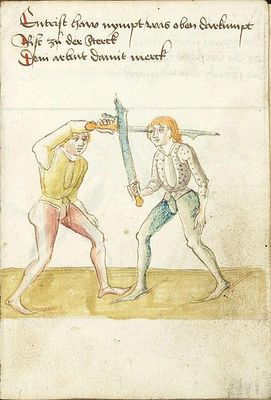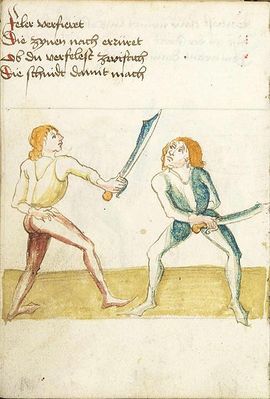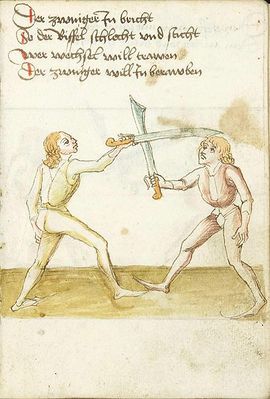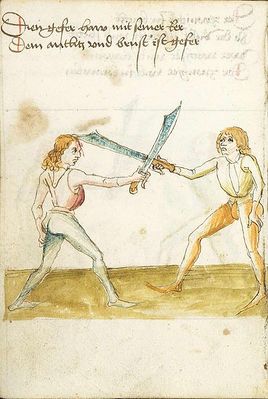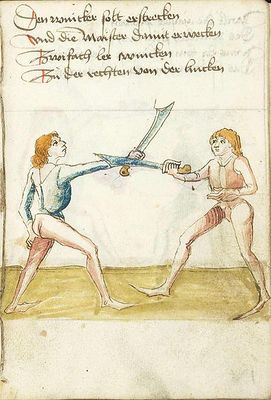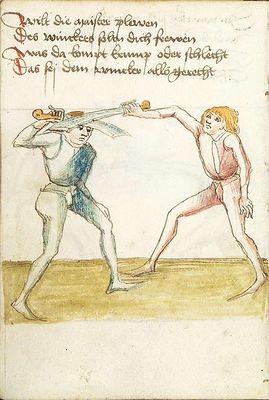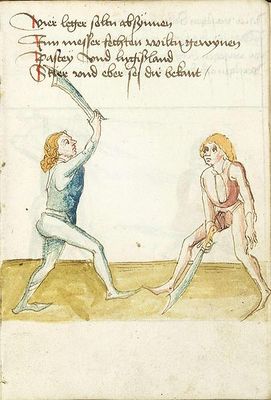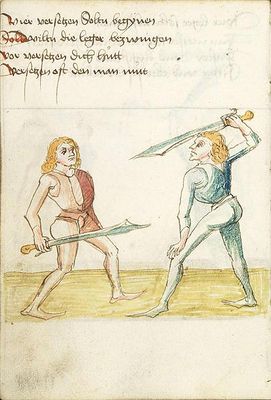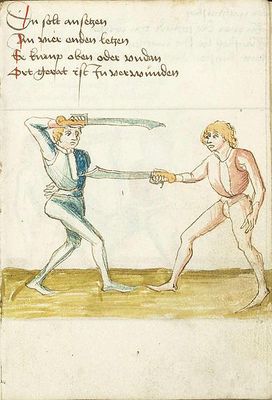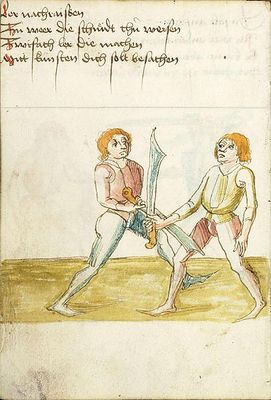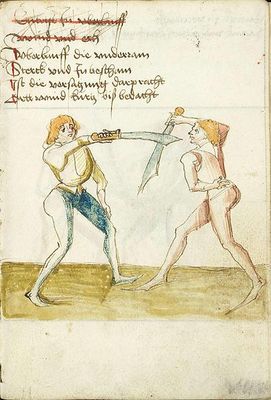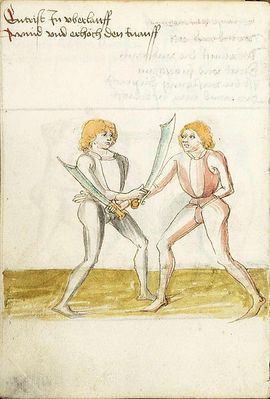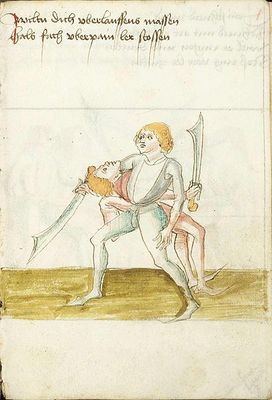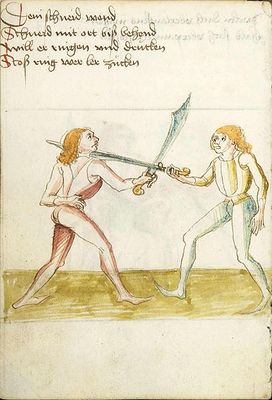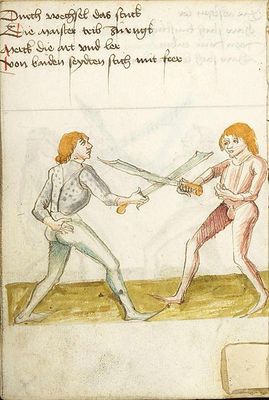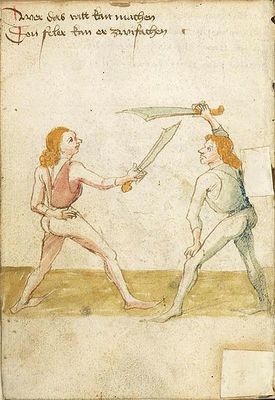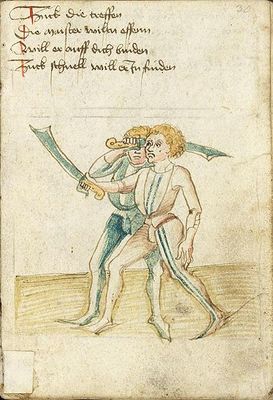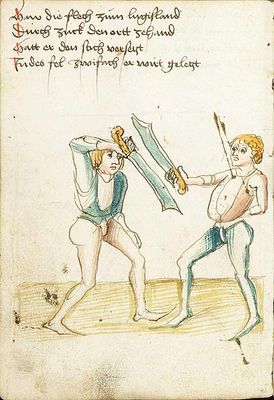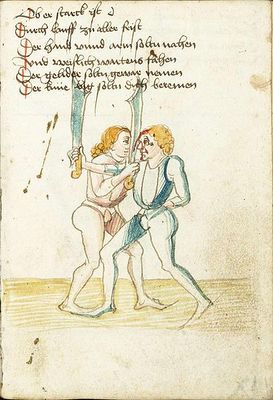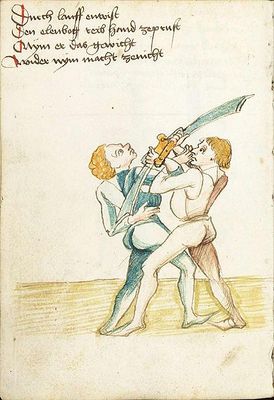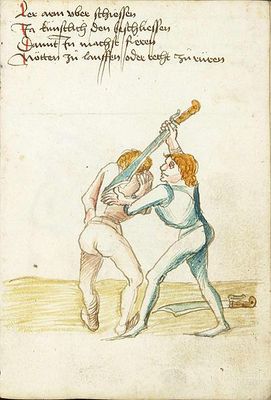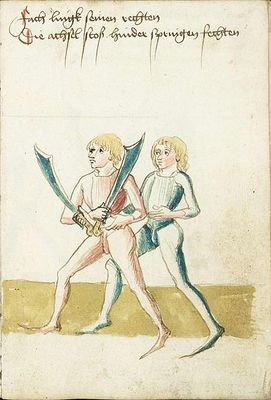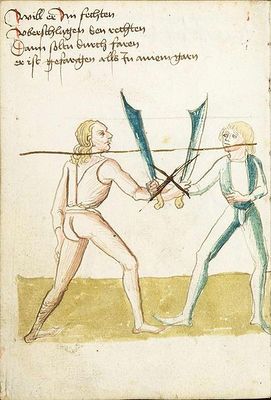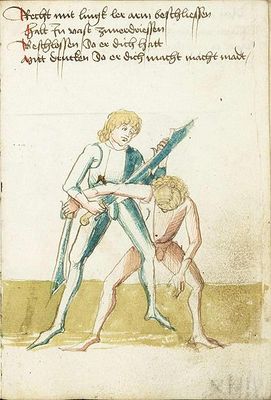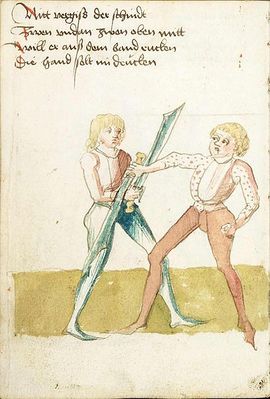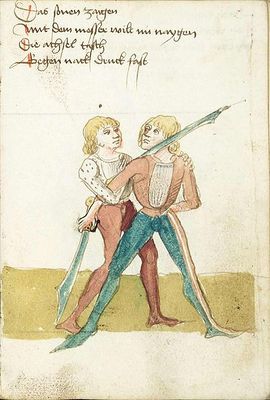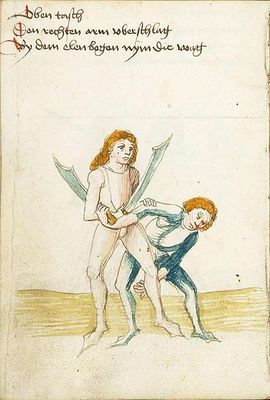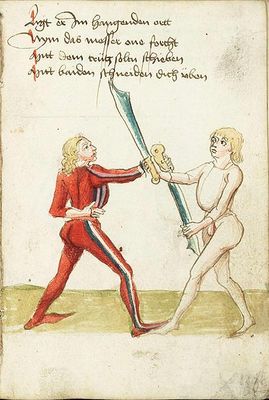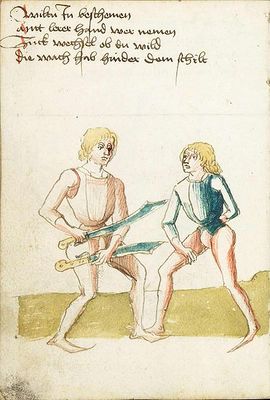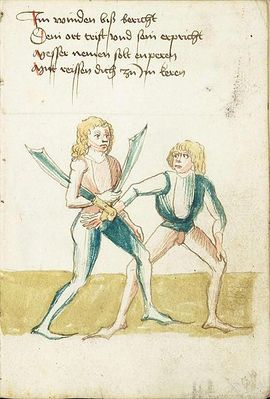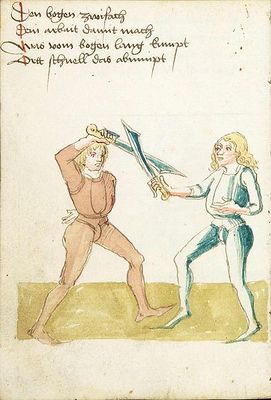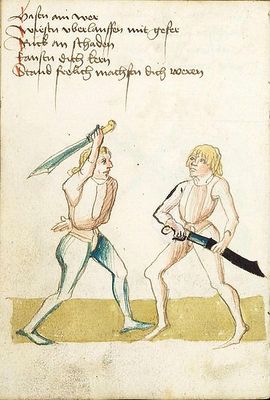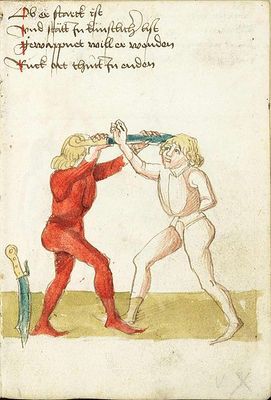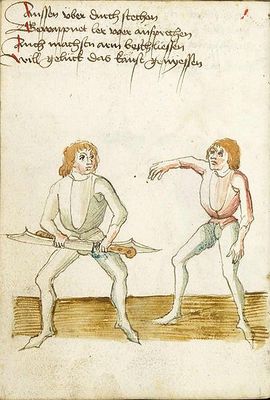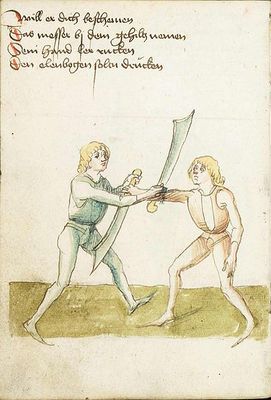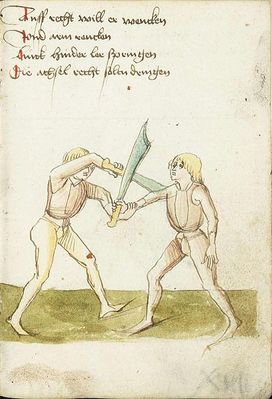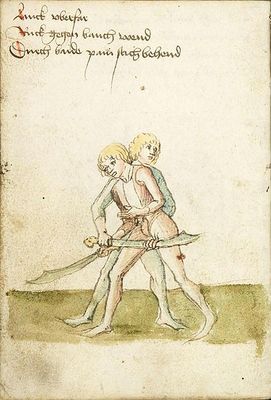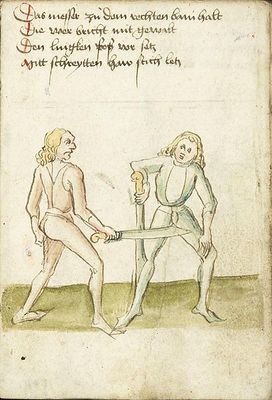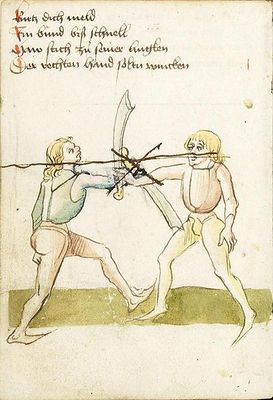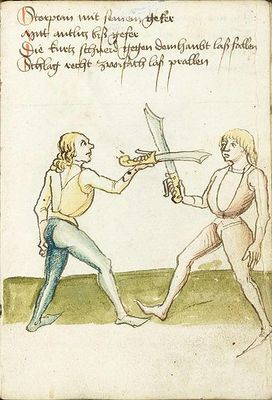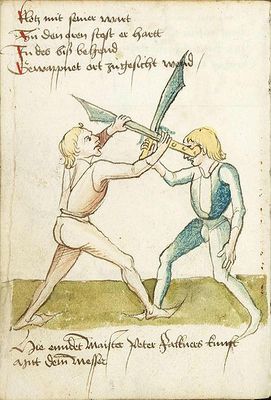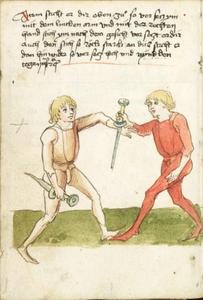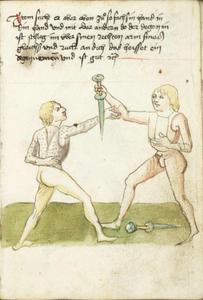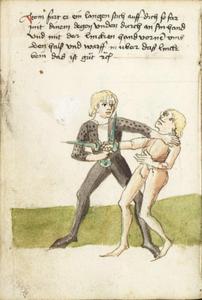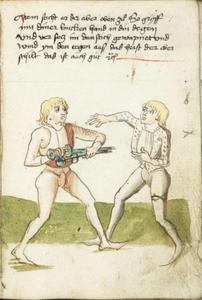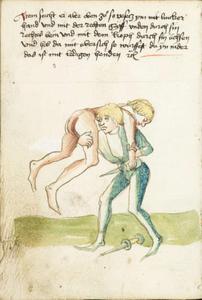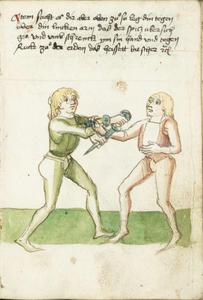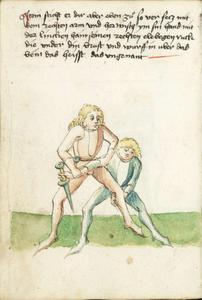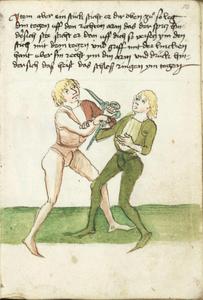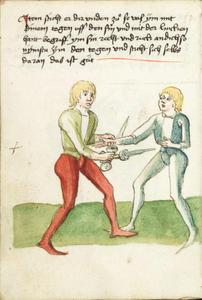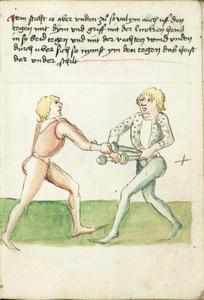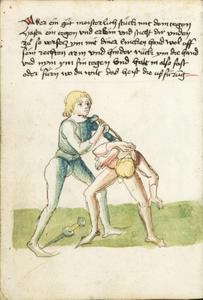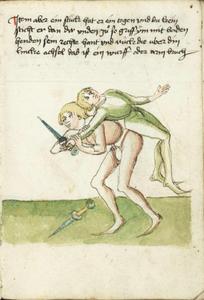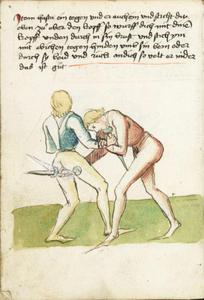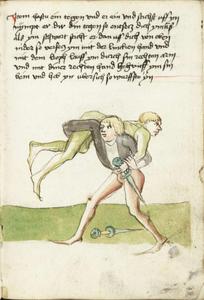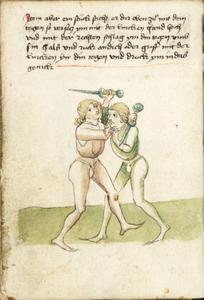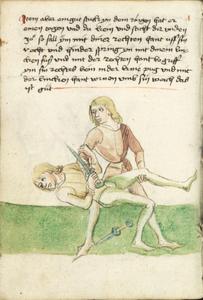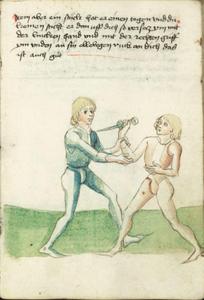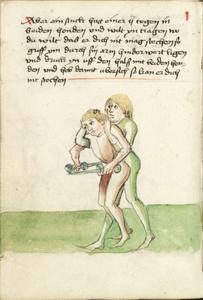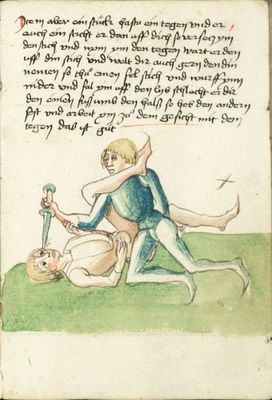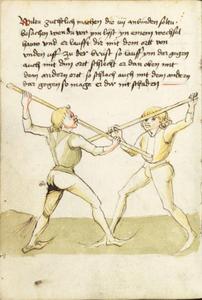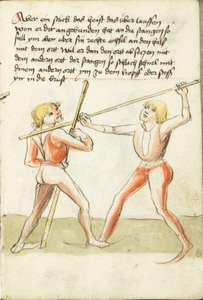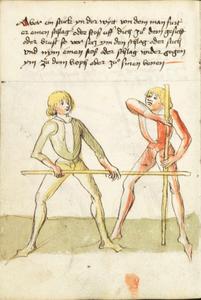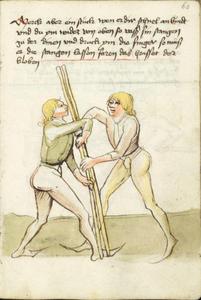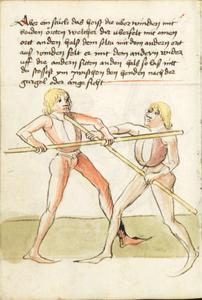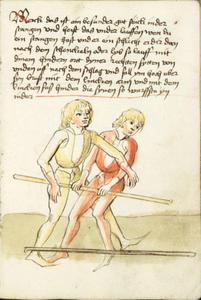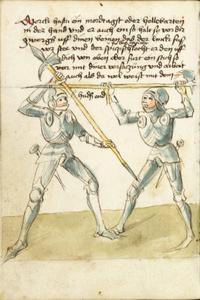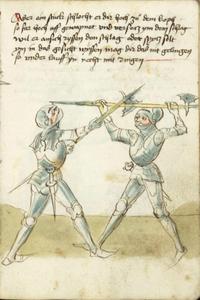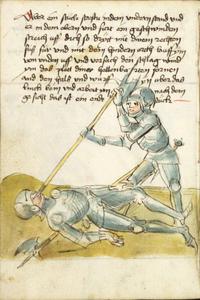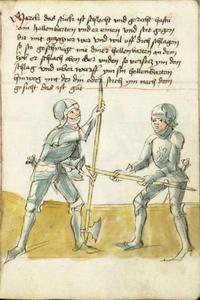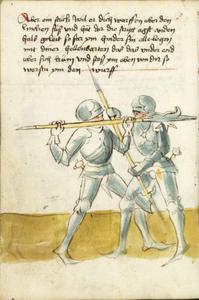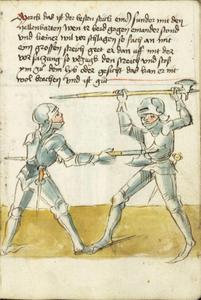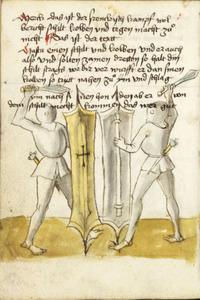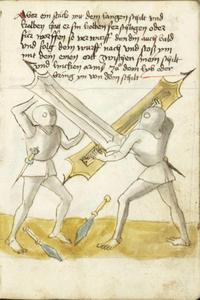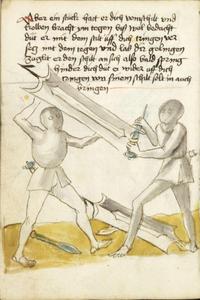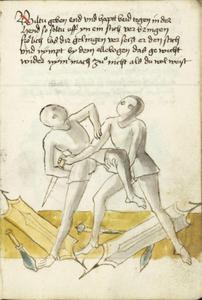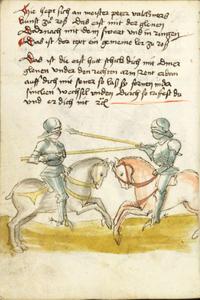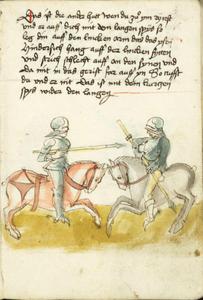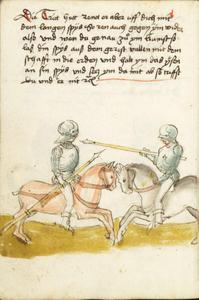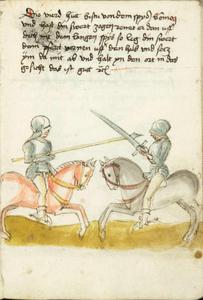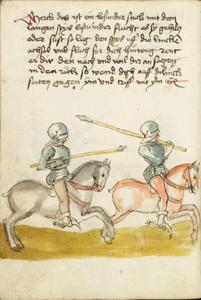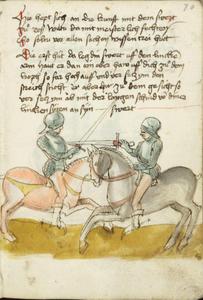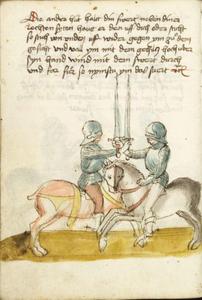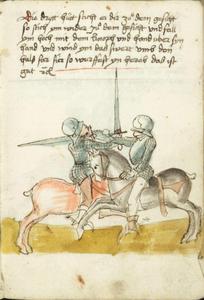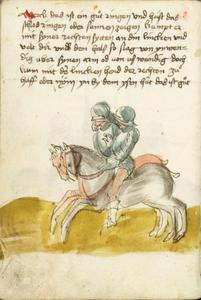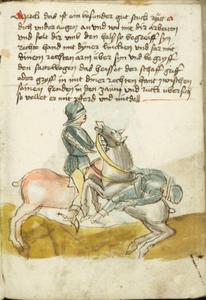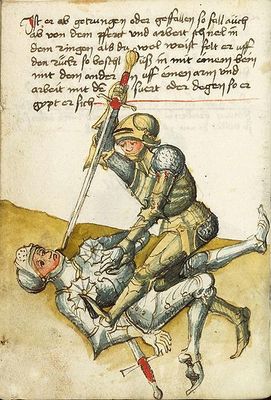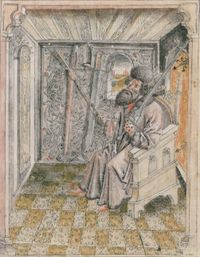|
|
You are not currently logged in. Are you accessing the unsecure (http) portal? Click here to switch to the secure portal. |
Difference between revisions of "Peter Falkner"
m (Text replacement - "Jörg Wilhalm Hutter" to "Jörg Wilhalm") |
|||
| (3 intermediate revisions by the same user not shown) | |||
| Line 58: | Line 58: | ||
In the 1490s, Falkner seems to have produced at least two manuscript fencing manuals (becoming the first member of the Brotherhood of Saint Mark to do so, unless [[Hans Talhoffer]] were also a member). Sadly, only the shorter of the two manuscripts, ''Kunste Zu Ritterlicher Were'' ([[Kunste Zu Ritterlicher Were (MS KK5012)|MS KK5012]]),<ref>[[Christian Henry Tobler|Tobler, Christian Henry]]. ''In Saint George's Name: An Anthology of Medieval Fighting Arts''. Wheaton, IL: [[Freelance Academy Press]], 2010. p 11</ref> survives. This fully-illustrated manuscript includes a sword section is based on Liechtenauer's Recital and a messer section based on that of [[Johannes Lecküchner]] (though in both cases with considerable alteration and elaboration by Falkner, and several short sections on other weapons which appear to be entirely original. | In the 1490s, Falkner seems to have produced at least two manuscript fencing manuals (becoming the first member of the Brotherhood of Saint Mark to do so, unless [[Hans Talhoffer]] were also a member). Sadly, only the shorter of the two manuscripts, ''Kunste Zu Ritterlicher Were'' ([[Kunste Zu Ritterlicher Were (MS KK5012)|MS KK5012]]),<ref>[[Christian Henry Tobler|Tobler, Christian Henry]]. ''In Saint George's Name: An Anthology of Medieval Fighting Arts''. Wheaton, IL: [[Freelance Academy Press]], 2010. p 11</ref> survives. This fully-illustrated manuscript includes a sword section is based on Liechtenauer's Recital and a messer section based on that of [[Johannes Lecküchner]] (though in both cases with considerable alteration and elaboration by Falkner, and several short sections on other weapons which appear to be entirely original. | ||
| − | The longer of the two manuscripts, known as the [[Falkner Turnierbuch]], seems to have been destroyed by Prussian bombardment during the Siege of Strasbourg in 1870. What little we know about its contents comes from records made before this time, which seem to indicate a manuscript of at least 111 folia containing an anthology of treatises by other masters of the Liechtenauer tradition, as well as a few works of unknown origin. There is also a possible third Falkner manuscript, the apparently-anonymous [[Cluny Fechtbuch (Cl. 23842)|MS Cl. 23842]], whose illustrations bear a strong resemblance to the artwork in KK5012 and which seems to even directly allude to it.<ref>Based on the caption "Here begin Peter's | + | The longer of the two manuscripts, known as the [[Falkner Turnierbuch]], seems to have been destroyed by Prussian bombardment during the Siege of Strasbourg in 1870. What little we know about its contents comes from records made before this time, which seem to indicate a manuscript of at least 111 folia containing an anthology of treatises by other masters of the Liechtenauer tradition, as well as a few works of unknown origin. There is also a possible third Falkner manuscript, the apparently-anonymous [[Cluny Fechtbuch (Cl. 23842)|MS Cl. 23842]], whose illustrations bear a strong resemblance to the artwork in KK5012 and which seems to even directly allude to it.<ref>Based on the caption "Here begin Peter's pieces: the sword-taking with counters and grappling. This is painted according to the Record, or according to the Running Through [rather than] the Record." (''Hie hebendt peters stuck an: die swert nemen mit pruchen und ringen. Lasz ab malen nach deme zetel oder nach dem durchlauffen…[illegible] zettel'') on [[:File:CL23842 47r.jpg|f 47r]]. Compare with the piece on [http://commons.wikimedia.org/wiki/File:Ms._KK5012_15r.jpg f 15r] of Falkner's work.</ref> |
Falkner's artwork resembles to some extent the earlier treatises of [[Paulus Kal]], which may have been his inspiration, and his art seem in turn to have influenced [[Jörg Wilhalm]] (especially if he created Cl. 23842). | Falkner's artwork resembles to some extent the earlier treatises of [[Paulus Kal]], which may have been his inspiration, and his art seem in turn to have influenced [[Jörg Wilhalm]] (especially if he created Cl. 23842). | ||
| Line 1,363: | Line 1,363: | ||
== Additional Resources == | == Additional Resources == | ||
| − | + | {{bibliography}} | |
| − | |||
== References == | == References == | ||
Latest revision as of 19:09, 29 October 2023
| Peter Falkner | |
|---|---|
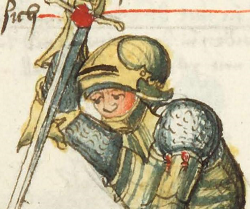 | |
| Born | ca. 1460s |
| Died | after 1506 |
| Occupation | Fencing master |
| Citizenship | Frankfurt am Main, Germany |
| Movement | Marxbrüder |
| Influences | |
| Influenced | |
| Genres | Fencing manual |
| Language | Early New High German |
| Notable work(s) | Kunste Zu Ritterlicher Were |
| Manuscript(s) |
|
| First printed english edition |
Tobler, 2011 |
| Translations | Deutsch-Übersetzung |
Peter Falkner (Peter Faulkner, Petter Falckner) was a 15th century German fencing master. His early life is uncertain, but he was certified as a Master of the Long Sword by the Marxbrüder in Frankfurt-am-Main some time before 1491.[1] Falkner was a witness of record to the guild's biannual treasury accounting in 1496, a task he performed again in 1506.[1] In 1502, he was elected as Captain (Hauptman) of the guild, and he seems to have served an unusual three consecutive terms.[1][2]
In the 1490s, Falkner seems to have produced at least two manuscript fencing manuals (becoming the first member of the Brotherhood of Saint Mark to do so, unless Hans Talhoffer were also a member). Sadly, only the shorter of the two manuscripts, Kunste Zu Ritterlicher Were (MS KK5012),[3] survives. This fully-illustrated manuscript includes a sword section is based on Liechtenauer's Recital and a messer section based on that of Johannes Lecküchner (though in both cases with considerable alteration and elaboration by Falkner, and several short sections on other weapons which appear to be entirely original.
The longer of the two manuscripts, known as the Falkner Turnierbuch, seems to have been destroyed by Prussian bombardment during the Siege of Strasbourg in 1870. What little we know about its contents comes from records made before this time, which seem to indicate a manuscript of at least 111 folia containing an anthology of treatises by other masters of the Liechtenauer tradition, as well as a few works of unknown origin. There is also a possible third Falkner manuscript, the apparently-anonymous MS Cl. 23842, whose illustrations bear a strong resemblance to the artwork in KK5012 and which seems to even directly allude to it.[4]
Falkner's artwork resembles to some extent the earlier treatises of Paulus Kal, which may have been his inspiration, and his art seem in turn to have influenced Jörg Wilhalm (especially if he created Cl. 23842).
Contents
Treatise
Long Sword
Messer
Dagger
Staff
Poleax
Longshield
Mounted Fencing
Copyright and License Summary
Additional Resources
The following is a list of publications containing scans, transcriptions, and translations relevant to this article, as well as published peer-reviewed research.
- Kirchhoff, Chassica (2018). "Visualizing the Fight Book Tradition: Collected Martial Knowledge in the Thun-Hohenstein Album." Acta Periodica Duellatorum 6(1): 3-45. doi:10.2478/apd-2018-0001.
- Kirchhoff, Chassica (2023). The Thun-Hohenstein Album: Cultures of Remembrance in a Paper Armory. Woodbridge: Boydell Press. ISBN 978-1837650439.
- Tobler, Christian Henry (2010). In Saint George's Name: An Anthology of Medieval German Fighting Arts. Wheaton: Freelance Academy Press. ISBN 978-0-9825911-1-6.
- Tobler, Christian Henry (2011). Captain of the Guild: Master Peter Falkner's Art of Knightly Defense. Wheaton: Freelance Academy Press. ISBN 978-1-937439-09-5.
- Tobler, Christian Henry (2022). Lance, Spear, Sword, & Messer: A German Medieval Martial Arts Miscellany. Wheaton: Freelance Academy Press. ISBN 978-1-937439-64-4.
- Welle, Rainer (2017). "Ein unvollendetes Meisterwerk der Fecht- und Ringkampfliteratur des 16. Jahrhunderts sucht seinen Autor: der Landshuter Holzschneider und Maler Georg Lemberger als Fecht- und Ringbuchillustrator?." Codices manuscripti & impressi S12. Purkersdorf: Verlag Brüder Hollinek. ISBN 0379-3621.
References
- ↑ Jump up to: 1.0 1.1 1.2 Anonymous. "Ordnung und Chronik der Fechtbruderschaft Unserer Lieben Frau und Sankt Markus zu Frankfurt 1491 - 1566" (in Early New High German). Untitled [manuscript]. Comp. Paulus Hector Mair. Codex I.6.2º.5. Augsburg, Germany: Universitätsbibliothek Augsburg, 1566.
- ↑ The Chronik der Fechtbruderschaft lists him as Captain in 1502 and 1504, and does not mention a new Captain until 1508. There is no indication of who held the office during the 1506-1507 term, so Falkner may possibly have continued during that time.
- ↑ Tobler, Christian Henry. In Saint George's Name: An Anthology of Medieval Fighting Arts. Wheaton, IL: Freelance Academy Press, 2010. p 11
- ↑ Based on the caption "Here begin Peter's pieces: the sword-taking with counters and grappling. This is painted according to the Record, or according to the Running Through [rather than] the Record." (Hie hebendt peters stuck an: die swert nemen mit pruchen und ringen. Lasz ab malen nach deme zetel oder nach dem durchlauffen…[illegible] zettel) on f 47r. Compare with the piece on f 15r of Falkner's work.
- ↑ alt: side
- ↑ alt: weapons
- ↑ Or Curved
- ↑ Or Cross, Barrier
- ↑ Or Canted, Slanted, Difficult to See
- ↑ Or Vertex, Scalper
- ↑ Ambiguous “from the right”, “properly” or “directly”
- ↑ Indes - Both within and during
- ↑ I changed this from the passive voice to the active, because it sounds weird. literally: "The war is not prone to you."
- ↑ Ambiguous “to the right”, “properly” or “directly”
- ↑ Leger - guards
- ↑ Versetzen - parrying
- ↑ Überlaufen has the connotations: to overwhelm, overflow, bypass, stride across.
- ↑ Überlaufen has the connotations: to overwhelm, overflow, bypass, stride across. It is used as a noun here.
- ↑ Das »g« könnte auch ein »h« sein.
- ↑ Kraków adds a final clause: "when you are far from one another".

